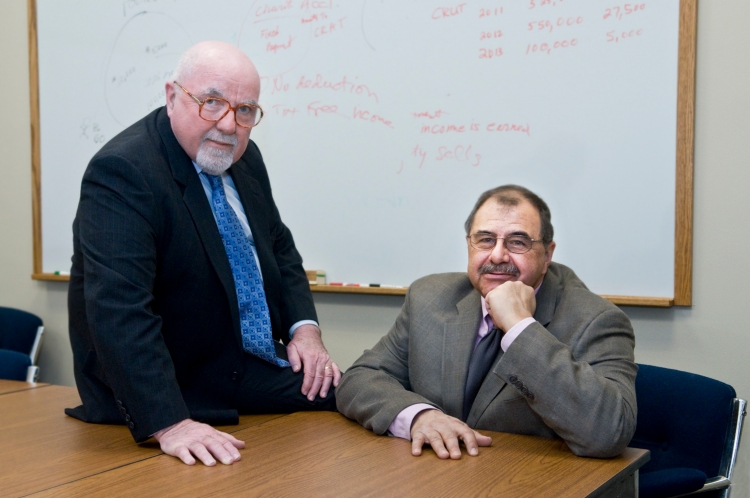
By
Although the Great Recession of 2007-2011 will resonate through the philanthropic sector over the next half-century, Greater Boston households and estates could give $600 billion to more than $1 trillion to charities between now and 2061, according to a new report by Boston College researchers.
The estimates are among the findings of "The Transfer of Wealth in Greater Boston: The Toll of the Recession and Prospects for the Future," a study by Center on Wealth and Philanthropy at Boston College Director Paul Schervish and Associate Director John Havens that was released last week at an Understanding Boston forum.
The report, based on Wealth Transfer and Potential for Philanthropy in the Boston Metropolitan Area, is a follow-up to the researchers' 2006 study on the Great Wealth Transfer and its impact on Greater Boston. That study — which, along with the just-released report, was commissioned by the Boston Foundation — found that an estimated $381 billion (in 2007 dollars) in Greater Boston household wealth would be donated to charities by 2055 in lifetime donations and charitable bequests, as part of a wealth transfer of $1.25 trillion dollars over that time period.
In the follow-up report, Havens and Schervish say that the recession erased an estimated $350 billion of the anticipated wealth transfer, reducing it from an estimated $1.86 trillion transferred in Greater Boston by 2061 to $1.51 trillion. Even so, charities could collect an estimated $627 billion (in 2007 dollars) in donations between 2007 and 2061.
The increase in the charitable impact is largely driven by a major shift in the amount donors are expected to give to charity during their own lifetimes.
“This report shows that Greater Boston’s commitment to philanthropy will only rise in the coming decades,” said Boston Foundation President and CEO Paul S. Grogan. “High-wealth households who were able to get through the recession with much of their assets still intact are already giving generously, but we must be smart to ensure that our policies and strategies maximize the power of that philanthropy in the coming decades.”
While Massachusetts has proven relatively resilient in its recovery from the recession, 91 percent of Greater Boston’s 1.7 million households saw their net worth decline in 2008-2009, according to Schervish and Havens, with households under $100,000 net worth faring especially poorly.
The authors highlight implications of the changes in philanthropy since the Great Recession, such as lingering uncertainty about the economy and tax laws governing charitable donations, income and estates, as well as opportunities for charities and non-profits to engage with donors who are becoming more engaged and strategic with their philanthropy. The greater prevalence of donor-advised funds means higher-income families and individuals can play a larger role in their own philanthropy without operating and administering a separate foundation, say Schervish and Havens, and strategic partnerships may provide a means for smaller foundations and nonprofits to offer donors more sophisticated vehicles for lifetime and bequest gifts.
Lifetime giving, which now accounts for 13 to 17 percent of wealth transfer, is expected to eclipse bequests by 2061. The model predicts that in the short term (2007-2026), 47 percent of all potential gifts to charity (or $92.42 billion) will be made during a donor’s lifetime and the remainder will come from charitable bequests. In the long-term scenario, that percentage rises dramatically to 64 percent (or $399.72 billion), exceeding the amount of bequests. Bequests account for the remaining $227.58 billion in estimated giving.
The most immediate impact of this lifetime giving trend is among those between 65 and 79 years of age, who are transferring assets out of their portfolios into trust, family foundations, donor advised funds and other vehicles at higher rates. While the overall value of final estates distributed 2007-2061 will change only slightly from the estimate for 2001-2055 – this and other increases in lifetime gifts will drive higher overall potential giving.
“While the models used by researchers assumed an average economic growth rate of 2 percent over the forecast period,” said Havens, the study’s major architect, “an economy that grows more quickly (or slowly) will have a major impact on potential charitable giving. A growth rate of 4 percent, instead of 2 percent, would drive potential charitable giving from $195 billion to $240 billion in 2007-2026, and from $627 billion to $1.629 trillion in 2007-2061.”
Schervish, a professor of sociology, said, “It is important to remember that none of the projections is written in stone. Not only will higher rates of economic growth provide for greater charitable giving. More giving also will be spurred by the ways charities act to deepen the engagement and self-fulfillment of their donors as they enhance the well being of their beneficiaries.”
To read the report, see http://bit.ly/Yb7CeE



